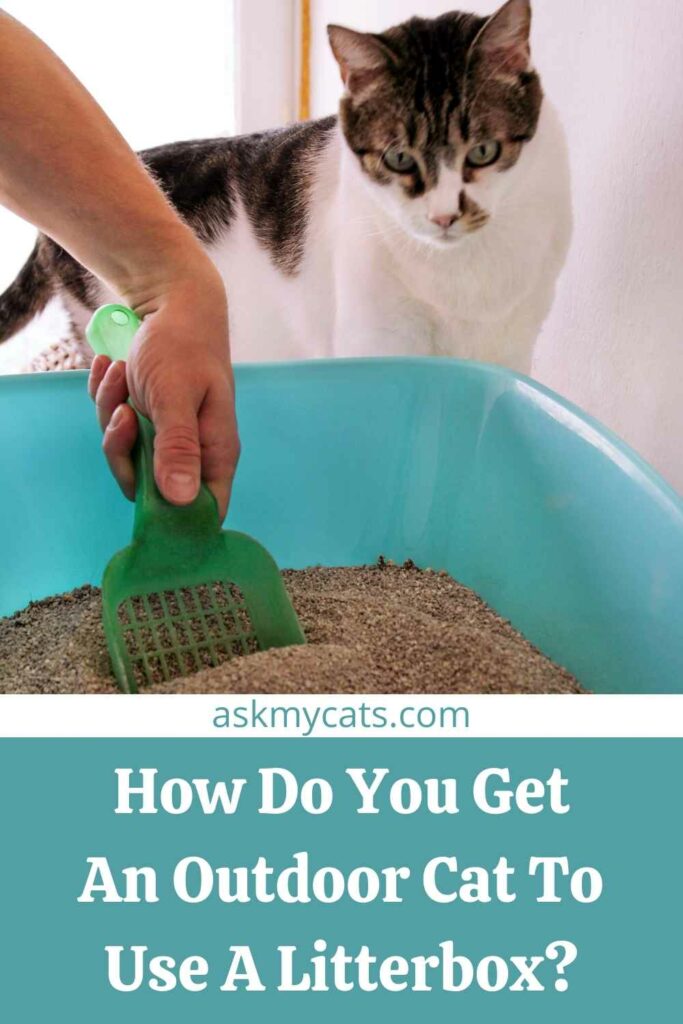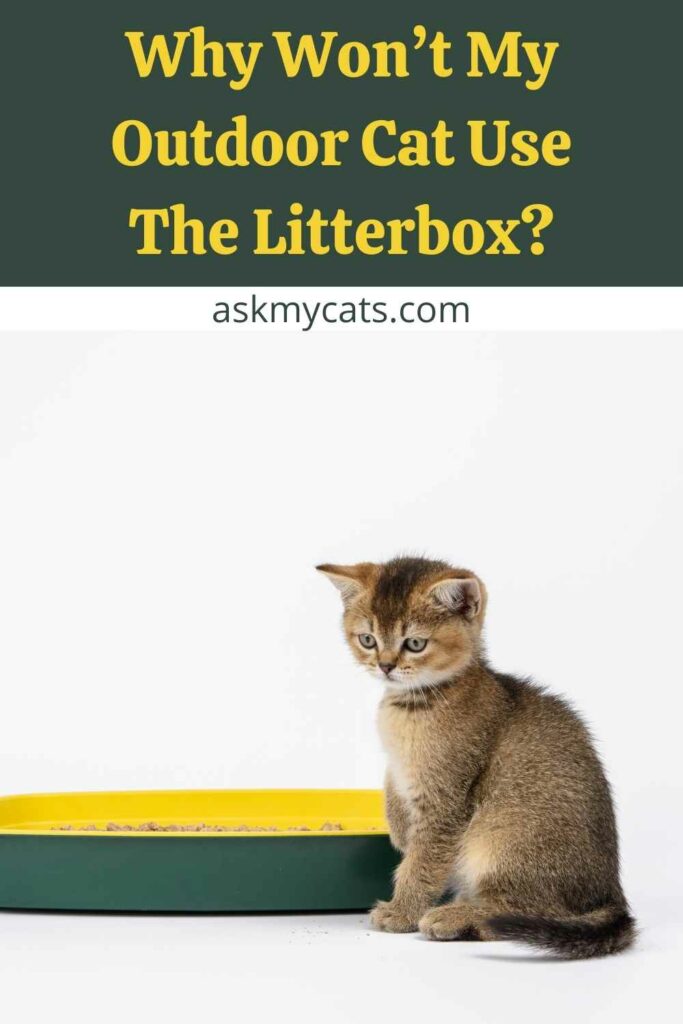At an early age, most cats learn how to litter from their mother. If a stray cat mother uses the soft garden soil as a restroom, her kitten may follow suit.
You can train a stray cat to use a litterbox by placing your cat in the litter box on a regular basis, especially after a meal. Place him in the box after he has eaten for around 20 minutes.
It might be difficult to train a stray cat to use a litter box if you have adopted him. Today’s article will provide you with some helpful hints to make it a delight.


Give Your Cat the Perfect Day
Get the Free Ebook!
How Do You Get An Outdoor Cat To Use A Litterbox?
The litter box is the first consideration you should make before beginning this training process for an outdoor cat. If your cat doesn’t like his litter box, he may urinate himself elsewhere in the home.

The most common cause of a cat’s incorrect elimination is a little box. Your cat may not appreciate a little box that is too small for him. Furthermore, a tiny box may lead him to believe that it will fill up rapidly.
As your cat matures, you should invest in a spacious box that will keep your cat happy for at least a year. Having a larger box also gives him the impression of having more personal space.
Another thing to keep in mind is that you should select a box with low edges so that your little or old cat may easily enter.
After you’ve purchased a proper litter box, you’ll be asked this question. You might be unsure where to put the litter box so that your cat notices it and uses it.
So, if you’re educating your cat to use the litter box, it’s a good idea to have many litter boxes around the home. If you have more than one cat, you may need two or even three litter boxes.
The location of the litter box is also important. If your cat is unable to locate the litter box, he may seek out another location to bury his waste. So, where is the proper location?
To begin with, keep the litter box away from his food and drink. He believes that food and water are located inside his home, and those cats, by nature, prefer to defecate outside.
However, if the litter box is too far away from his activity zone, it may be bothersome. Also, some cats may feel timid if their litter box is in a crowded area with a lot of people walking by.
Why Won’t My Outdoor Cat Use The Litterbox?
Your outdoor cat doesn’t want to use the litterbox because he is accustomed to urinating in open spaces.

Clumping litter is preferred by most cats because it is less prone to adhere to their paws and is more pleasant to walk on. Additionally, clumping litter may make sweeping the litter box much easier.
While many people enjoy scented litter, these may cause allergic reactions in your cat. As a result, odourless litter is the best option. If you’re sensitive to scents, clean the litter box more often.
In addition, the level of litter in the box should be considered. Because cats enjoy digging, too much litter may be difficult for them and may even flow out of the box.
The depth of trash, according to some experts, should be roughly two inches. If your cat is a genuine digger, though, you should get him a four-inch-deep litter box.
Cleaning the litter box is essential for keeping the unpleasant odor out of your home. It would be beneficial if you scooped the box on a regular basis, at least once a day. Also, clean the entire box once a week and change the litter at least twice a week.
If your kitten refuses to use the litter box, you might place a small amount of waste in the box to remind him where to pee. However, don’t keep them there for too long or they’ll start to stink up your place.
Most cats prefer clumping litter because it is less likely to stick to their paws and is more comfortable to walk on. Clumping litter may also make sweeping the litter box a lot simpler.
While perfumed litter is popular, it may trigger allergic responses in your cat. As a result, the best alternative is odourless litter. Clean the litter box more frequently if you’re sensitive to odours.
The amount of litter in the box should also be examined. Too much litter may be difficult for cats to dig through, and it may even pour out of the box. According to some experts, waste should be around two inches deep.
Will A Stray Cat Know How Do You Use A Litterbox?
A stray cat will know how to use a litterbox through proper potty training.

You don’t need to spend much time with cats because they are quite easy to train. You’ll need to keep an eye on his schedule to figure out when he’ll need to go to the bathroom and send him to the box.
Generally, a cat will defecate and/or urinate after playing, running, or even eating. As a result, pay attention to your cat’s behaviour.
You should educate your cat how to use the litter box if he has never done so before. Put him in the box and show him how to rummage through the litter. Using your finger to scrape some litter away instead of his paw might help him learn how to dig.
Patience is the key here. You should have faith in your cat’s ability to learn such skills in the end. Also, if he can’t learn for the first time, don’t shout at him. It might cause anxiety or even a dread of using the toilet.
If he takes his trash out of the box, you should return it to its proper location. It might serve as a prompt for where to eliminate the next time.
Also, don’t forget to wipe up the strewn-about area. Once the cat detects the faeces, they may repeat the process. You may also keep his food and drink close to the out-of-the-box waste place to avoid him from eliminating there again.
Can You Train An Old Outdoor Cat To Use A Litterbox?
Yes, you can train an old outdoor cat to use a litterbox with some time and dedication.
The key distinction between litter box training a stray cat and litter box training a domesticated cat is that you will utilise soil with a stray cat. Because stray kittens are used to using dirt as a toilet, the smell of dirt will entice your cat to use the litter box. Don’t worry; this is merely a short-term solution.
Fill a tiny shoebox halfway with soil. You can start with the shoe box lid if the kitten is extremely young (5 to 6-weeks old) and has problems crawling inside the shoe box.
Place the box or box lid in a very tiny area once it has been filled with soil. A bathroom will work well, especially if it has tiles, which make cleaning up spills a breeze.
For the first several days, the kitten must be confined in this little space. This is due to the fact that kittens are little animals that may easily go lost in a normal-sized home. Most kittens will urinate or defecate wherever they find themselves if they can’t find their way back to the restroom.
Can Feral Cats Be Litterbox Trained?
Yes, feral cats can be litterbox trained by following the necessary training and routine.
In one part of the bathroom, the cat’s litter box should be located, and in another area, a water dish and food bowl should be located. The reason we put litter boxes in corners is that kittens like to urinate and defecate in corners. Kittens also don’t defecate in the same areas as their food and water.
As a result, your cat will not urinate in two corners of the room using this strategy. Furniture or anything else that will obscure a visible corner should be used to block the other corners.
Kittens usually defecate within half an hour after eating, so keep an eye on them after they eat.
Look for meowing, clawing the floor, or glancing about as indicators that it’s time to go. If this occurs, immediately place the kitten in the litter box. Praise and pet the kitten if it runs away.
Do not chastise your kitten if she has an accident. This is simply going to frighten her. Instead, pick up the faeces and deposit it in the litter box, if feasible. This way, your cat will know where it needs to go.
After each meal, keep an eye on your kitten and repeat the process of scooping him up and depositing him in the litter box.
Your kitten should begin to grasp the technique after a few days. Make a point of keeping the litter box clean.
Gradually incorporate some unscented litter into the ground. Litter should have entirely replaced the dirt after one week. Your cat should have a good handle on litter box training at this stage.
Frequently Asked Questions
Can a stray cat become an indoor cat?
Yes, that stray or alley cat may become your cherished home cat, but there are a few things to keep in mind. Feral cats are wild animals that have never been tamed or exposed to humans. Alley cats and stray cats have frequently been socialised and may have even been neutered and given medical attention.
What does it mean when a stray cat meows at you?
If a stray cat keeps meowing at you, it’s a sign that she’s attempting to get your attention. A cat’s approach of drawing your attention is to meow. She might be on the lookout for food, a family, or a pet. They don’t meow, and she isn’t a wild cat.
Do stray cats know to use a litter box?
Especially if they have been imprinted on anything else, recently adopted wild and stray cats may need to be actively trained to use a box filled with clay litter. Some stray dogs learn quickly, while others do not. Remember that a cat that lived outside had a lot of options.
Final Words
When cats are in pain or uncomfortable; their behaviour is unpredictable. They may link the pain with the litter box and attempt to avoid it if they have a urinary tract infection or are constipated. It’s also possible that they have an ingrown claw that makes digging in the litter difficult.
Leave your questions in the comments section below.
